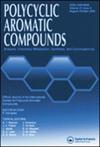香豆素-3-羧酸乙酯的光谱表征、量子化学、分子对接、抗菌和抗癌研究
IF 2.6
3区 化学
Q2 CHEMISTRY, ORGANIC
引用次数: 0
摘要
对香豆素-3-羧酸乙酯(ECC)分子进行了详细的理论和实验分析(FT-IR, FT-Raman, uv -可见光)。利用抗菌和抗癌活性研究了ECC化合物的药理学性质。首先,采用密度泛函理论B3LYP方法,采用高斯09 W程序,以6-311 G++ (d,p)基集对ECC分子进行优化。优化后的分子结构提供了ECC分子的谐波振动频率。对观测到的和计算得到的振动波数进行了分配,并发现它们具有很好的相关性。紫外可见吸收光谱分析表明,分子中含有π→π*和n→π*电子跃迁。Frontier分子轨道分析证实了ECC的分子反应性和生物活性,Mulliken原子电荷分布分析确定了分子的反应位点。抑菌试验表明,ECC化合物对多种细菌均有抑制作用,对肺炎克雷伯菌有明显的抑制作用。体外抗癌实验表明,ECC对A549肺癌细胞株的抑制作用强于HeLa宫颈癌细胞株。此外,硅分子对接研究进一步验证了ECC化合物可以抑制与肺癌相关的表皮生长因子受体(epidermal growth factor receptor)的功能。因此,本研究为肺癌治疗新药的开发奠定了基础。本文章由计算机程序翻译,如有差异,请以英文原文为准。
Spectroscopic Characterization, Quantum Chemical, Molecular Docking, Antibacterial and Anticancer Studies on Ethyl Coumarin-3-Carboxylate: an Antibacterial and Lung Cancer Agent
The detailed theoretical and experimental (FT-IR, FT-Raman, UV-visible) spectroscopy analyses of the Ethyl Coumarin-3-Carboxylate (ECC) molecule were carried out. The ECC compound’s pharmacological properties were also investigated, utilizing antibacterial and anticancer activity investigations. Initially, the ECC molecule was optimized by the density functional theory B3LYP method with a 6-311 G++ (d,p) basis set using the Gaussian 09 W program. The optimized molecular structure provides the harmonic vibrational frequencies of the ECC molecule. The observed and computed vibrational wavenumbers were assigned and found to be well correlated. UV-Vis absorption spectrum analysis indicates that the molecule contains π →π* and n → π* electronic transitions. The Frontier molecular orbital analysis confirmed the molecular reactivity and bioactivity of ECC, while the Mulliken atomic charge distribution analysis pinpointed the molecule’s reactive sites. Antibacterial testing demonstrated the ECC compound’s inhibitory effect on various bacterial strains, with a particular impact on Klebsiella pneumonia. In vitro, anticancer assessments showcased ECC's stronger inhibitory effects on A549 lung cancer cell lines compared to HeLa cervical cancer cell lines. Additionally, in silico molecular docking investigations provided further validation that the ECC compound can inhibit the function of the epidermal growth factor receptor, a factor associated with lung cancer. As a result, this study lays the foundation for the development of novel drugs for lung cancer treatment.
求助全文
通过发布文献求助,成功后即可免费获取论文全文。
去求助
来源期刊

Polycyclic Aromatic Compounds
化学-有机化学
CiteScore
3.70
自引率
20.80%
发文量
412
审稿时长
3 months
期刊介绍:
The purpose of Polycyclic Aromatic Compounds is to provide an international and interdisciplinary forum for all aspects of research related to polycyclic aromatic compounds (PAC). Topics range from fundamental research in chemistry (including synthetic and theoretical chemistry) and physics (including astrophysics), as well as thermodynamics, spectroscopy, analytical methods, and biology to applied studies in environmental science, biochemistry, toxicology, and industry. Polycyclic Aromatic Compounds has an outstanding Editorial Board and offers a rapid and efficient peer review process, as well as a flexible open access policy.
 求助内容:
求助内容: 应助结果提醒方式:
应助结果提醒方式:


